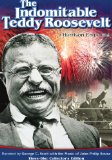Teddy Roosevelt has been somewhat of a dominant figure in my life these last few weeks. By coincidence, I have just finished reading an excellent collection of the man’s letters in a volume entitled The Scarlet Letters Of Theodore Roosevelt. These kinds of books are wonderful opportunities to get to know an historical figure through his own words, often directed at close friends and family with whom he felt comfortable enough to refrain from censoring his words quite so much. Then there’s the two Night At The Museum films which I recently watched and reviewed for these pages. I live in Tampa and was recently near the area in which Teddy trained and assembled his famous Rough Riders for their historic contribution to the Spanish American War. Finally, I had just finished watching a more detailed biography on one of those documentary stations. So, wouldn’t you know it that I would find at my doorstep courtesy of my local UPS carrier, a copy of The Indomitable Teddy Roosevelt. I’m quite the history buff. I taught years of AP Government and American History. My specialty has always been the presidents. I was really looking forward to watching this one.
This is a documentary unlike any other I’ve ever seen. The piece is narrated by George C. Scott. The narration script is mostly very surface kinds of things. The program rarely goes into any kind of detail about the man. There’s a lot of fluff and bravado descriptions of the subject, but I can’t imagine you really getting to know the man himself from anything you encounter here. If you have knowledge about Teddy Roosevelt at all, you already know all this stuff. What the documentary lacks in detailed information it attempts to make up for in dramatizations. Actors portray Roosevelt and his family in reenactments of some of the narration. We’re talking mostly family events. While the filmmakers never try to deceive the audience or suggest that this footage is the real deal, the program did catch more than its fair share of heat for the stylistic choice. But in the end, these reenactments appear as trivial as most of the program itself.
Another aspect of the dramatization effort is found in the soundtrack. Filmmaker Harrison Engle used the music of Roosevelt’s contemporary John Phillip Sousa to create a personality to match Roosevelt’s. In places it is actually quite an enhancement. In other places it’s more like everything is staged as a backdrop to the music. It’s all a rather uneven affair and plays more for entertainment value than education. The PBS Presidents series offers a far more in-depth look at the 26th President of the United States.
Video
The documentary is presented in its original full screen aspect ratio. It isn’t fair to have very high expectations here. The vintage footage and photographs are quite old and will never look much better. Still, compression artifact is a huge problem here. When you look at still photographs, they appear to shift and move as if they were prepared in layers. Black levels suffer badly here. Even the newly produced footage has such a soft and blurred quality that it looks more like a video tape dub than a DVD.
Audio
The Dolby Digital 2.0 barely makes the dialog work. The Sousa music blares itself often into distortion. There just isn’t a lot to love about this presentation.
Special Features
This is a 3 disc set. You get the film on one disc. Another disc is a CD of the Sousa music in the documentary. The third disc contains the following:
Harrison Engle Interview: (14:05) It begins with a hyped narration by Engle to stills from the film. Finally, it settles into a more traditional selection of sound bites from the filmmaker. He talks about the inspiration for the film, the financing woes, and the controversial use of reenactments.
Text features include: Teddyisms (Quotes), John Phillip Sousa Bio, and Roosevelt’s Inaugural Address. The disc is completed with a photo gallery.
Final Thoughts:
You might not know it from this particular film, but Teddy Roosevelt was a very interesting man. He was the first president to ride in an airplane. He was first to be filmed. He was the first president to have a telephone. He was the first to leave the continent while in office. He was the first to drive in a motorcar limo. His exploits in Cuba have been the fodder of heroic tales both true and untrue. He set aside more conservation land than any other president when he created the National Parks and Monuments. He was ever larger than life. His African hunting expeditions have provided a larger collection of species in the Smithsonian than any other man’s. He built the Panama Canal. You’d think that a man who had accomplished all of this would deserve a little more detail to his story. But, as the man once said himself: “It’s not the critic who counts”.




